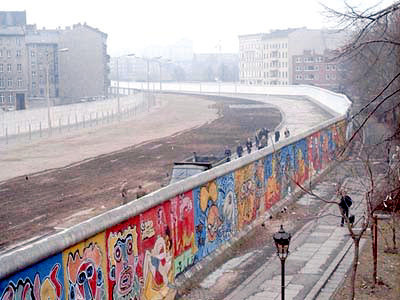
Mikhail Gorbachev was instrumental in the fall of the Berlin wall and the end of the cold war.

"The Anti Fascist Protection Barrier".

The Berlin wall was used as a canvas for many artists.

Space Race
In the Second World War, missiles Germans fell on England. They were the V-1 and V-2 (Wernher von Braun, 1944). Its target was hundreds of kilometers from its launch base after rising more than 80 km above the surface. They possessed alcohol rocket engines and liquid oxygen. When the war ended in 1945, German scientists emigrated to the United States and the USSR and the race is began for space and domination of the skies.On October 4, 1957, the intercontinental ballistic missile R-7, redesigned to carry a satellite into its interior was launched by the USSR, it bore the name Sputnik I , 84 kg. First signs of a radio station transmission from space. On 3 November the same year Sputnik II was placed in orbit.. On January 4 and June 13, 1958, both mills fell on Earth. Its orbit was still at a height where there were vestiges of our atmosphere. Better luck would run the dogs Belka and Strelka, on board the fifth satellite in the series, were recovered alive after orbating 18 times around the earth and reach 450 km altitude. The tenth and last of the series was released on March 25, 1961. United States did not remain impassive. The Explorer I was launched on 31 January 1958 and weighed 14 kg. NASA: Also in 1958, the civilian agency National Aeronautics and Space is created. The December 13, 1958, the US sent the missile Jupiter with monkey Gordo as crew. He died after the capsule sank in the sea. US wanted definitely ahead of the USSR in the conquest of space: NASA announces to the world his intention to be the first to send a man into space. They would not get it.
The first steps have already been taken. You go to the Apollo program and after successive approximations and stays longer in space, finally the July 16, 1969 the Apollo XI (on the Saturn V) take achieve the objectives of the challenge set by president Kennedy. After five days in space, Neil Armstrong and Buzz Aldrin landed in the Sea of Tranquility, aboard the Eagle. Michael Collins would remain in the command module. This time an American first walked on the moon and the launches and landings of Soviet Moon into shadow at such a milestone. After these achievements the new career focused on the exploration of the planets by space probes. It began with Pioneer V (03/11/60) that the US launches on Venus. The capsule of Venera-4 (USSR 06/12/67) lands on Venus. Mariner-10 (USA 03/11/73) Mercury photography. Mars will be explored by the Mars series of Soviet and American probes Mariner. The Pioneer and Voyager will go to Jupiter, Saturn and Uranus. US reaffirms its leadership, as evidenced by the Sojourner, mobile robot exploring the Martian surface.
They are space stations where the Soviets have made great achievements, with its Soyuz and MIR projects to levels not reached the American Skylab station.
After the fall of the Union of Soviet Socialist Republics new space projects have progresses in partnership with a new era of open international cooperation between countries.
